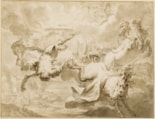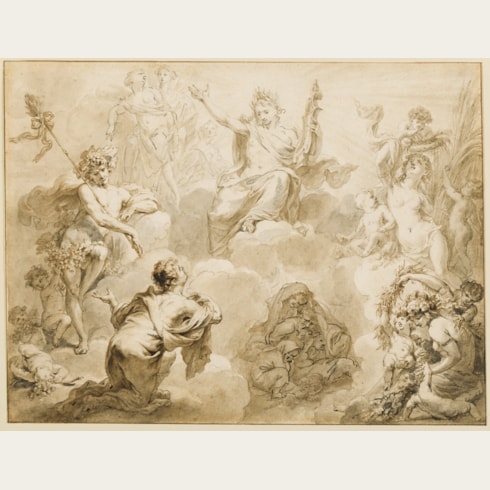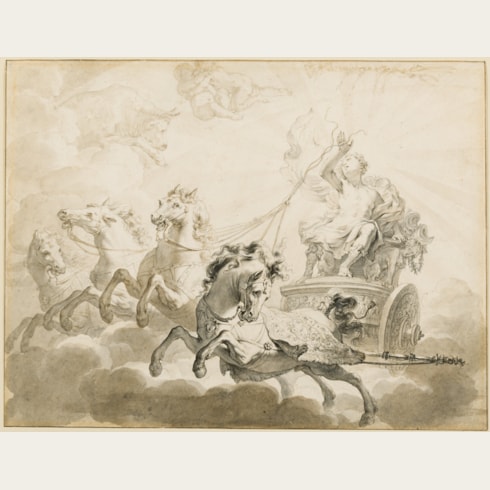Godfried MAES
(Antwerp 1649 - Antwerp 1700)
The Fall of Phaeton
Sold
Pen and brown ink and brown and gray wash, with framing lines in brown ink.
180 x 236 mm. (7 1/8 x 9 1/4 in.)
180 x 236 mm. (7 1/8 x 9 1/4 in.)
One of a series of eighty-three elaborate pen and wash drawings by Godfried Maes illustrating various episodes from Ovid’s Metamorphoses. Perhaps intended as book illustrations or designs for prints, these highly refined drawings were, however, never reproduced or published in Maes's lifetime. In 1717 the artist’s widow sold all the drawings to the artist Jacob de Wit, who later used some of them as models for his own designs for illustrations, engraved under the supervision of Bernard Picart, for a 1732 translation of The Metamorphoses into Dutch, French and English editions. The original drawings by Maes remained together until 1762, when they were dispersed at auction in Amsterdam.
Here, in the third of four drawings depicting the story of Phaeton, the fiery chariot of the Sun plunges to Earth, scorching the ground, drying up the seas and rivers, burning the mountains and turning much of Africa into a desert. ‘Then, truly, Phaethon sees the whole earth on fire. He cannot bear the violent heat, and he breathes the air as if from a deep furnace. He feels his chariot glowing white. He can no longer stand the ash and sparks flung out, and is enveloped in dense, hot smoke. He does not know where he is, or where he is going, swept along by the will of the winged horses.’
As her surface burns, Earth, in her agony, cries out to Jupiter, who is forced to intervene: ‘the all-powerful father of the gods climbs to the highest summit of heaven, from where he spreads his clouds over the wide earth, from where he moves the thunder and hurls his quivering lightning bolts, calling on the gods, especially on him who had handed over the sun chariot, to witness that, unless he himself helps, the whole world will be overtaken by a ruinous fate…He thundered, and balancing a lightning bolt in his right hand threw it from eye-level at the charioteer, removing him, at the same moment, from the chariot and from life, extinguishing fire with fierce fire. Thrown into confusion the horses, lurching in different directions, wrench their necks from the yoke and throw off the broken harness. Here the reins lie, there the axle torn from the pole, there the spokes of shattered wheels, and the fragments of the wrecked chariot are flung far and wide. But Phaethon, flames ravaging his glowing hair, is hurled headlong, leaving a long trail in the air, as sometimes a star does in the clear sky, appearing to fall although it does not fall. Far from his own country, in a distant part of the world, the river god Eridanus takes him from the air, and bathes his smoke-blackened face. There the Italian nymphs consign his body, still smoking from that triple-forked flame, to the earth, and they also carve a verse in the rock: HERE PHAETHON LIES WHO THE SUN’S JOURNEY MADE, DARED ALL THOUGH HE BY WEAKNESS WAS BETRAYED.’
Here, in the third of four drawings depicting the story of Phaeton, the fiery chariot of the Sun plunges to Earth, scorching the ground, drying up the seas and rivers, burning the mountains and turning much of Africa into a desert. ‘Then, truly, Phaethon sees the whole earth on fire. He cannot bear the violent heat, and he breathes the air as if from a deep furnace. He feels his chariot glowing white. He can no longer stand the ash and sparks flung out, and is enveloped in dense, hot smoke. He does not know where he is, or where he is going, swept along by the will of the winged horses.’
As her surface burns, Earth, in her agony, cries out to Jupiter, who is forced to intervene: ‘the all-powerful father of the gods climbs to the highest summit of heaven, from where he spreads his clouds over the wide earth, from where he moves the thunder and hurls his quivering lightning bolts, calling on the gods, especially on him who had handed over the sun chariot, to witness that, unless he himself helps, the whole world will be overtaken by a ruinous fate…He thundered, and balancing a lightning bolt in his right hand threw it from eye-level at the charioteer, removing him, at the same moment, from the chariot and from life, extinguishing fire with fierce fire. Thrown into confusion the horses, lurching in different directions, wrench their necks from the yoke and throw off the broken harness. Here the reins lie, there the axle torn from the pole, there the spokes of shattered wheels, and the fragments of the wrecked chariot are flung far and wide. But Phaethon, flames ravaging his glowing hair, is hurled headlong, leaving a long trail in the air, as sometimes a star does in the clear sky, appearing to fall although it does not fall. Far from his own country, in a distant part of the world, the river god Eridanus takes him from the air, and bathes his smoke-blackened face. There the Italian nymphs consign his body, still smoking from that triple-forked flame, to the earth, and they also carve a verse in the rock: HERE PHAETHON LIES WHO THE SUN’S JOURNEY MADE, DARED ALL THOUGH HE BY WEAKNESS WAS BETRAYED.’
The Flemish painter and draughtsman Gotfried Maes studied in his native Antwerp with his father and with the painter Pieter van Lint. He was admitted to the painter’s guild in Antwerp in 1672, becoming dean of the guild ten years later. He spent his entire career in Antwerp, receiving commissions for altarpieces and history paintings from churches and collectors in Antwerp, Brussels and Liège. Much of his work is in a grand scale, such as a large altarpiece of The Martyrdom of Saint George, painted in 1681 for the Antwerp church of St. Joris and today in the Koninklijk Museum voor Schone Kunsten in Antwerp, and Maes may be regarded as among the last of the Flemish Baroque artists. Among his important patrons was Eugen Alexander Franz, Prince of Thurn and Taxis, for whose palace in Brussels he painted an allegorical ceiling painting glorifying the Thurn and Taxis family. Maes worked as a designer of tapestry cartoons, often in collaboration with the tapestry workshop of Urbanus Leyniers in Brussels, and also produced book illustrations and a number of etchings. One of his last major decorative projects was the ceiling decoration of the Palace of Coudenberg in Brussels for the governor of the Spanish Netherlands, Maximilian II Emanuel, Elector of Bavaria; on which he worked between 1697 and 1700.
A gifted draughtsman, Maes produced numerous drawings, both as preparatory studies for paintings and as finished, independent works. Arguably the most significant example of the latter group are a series of 83 elaborate pen and wash drawings illustrating various episodes from Ovid’s Metamorphoses. Perhaps intended as book illustrations or designs for prints, these refined drawings were, however, never reproduced or published in his lifetime. In 1717 the artist’s widow sold all the drawings to the art dealer Jacob de Wit, and they were eventually used as illustrations for a 1732 translation of the Metamorphoses into French. The original drawings by Maes remained together until 1762, when they were dispersed at auction in Amsterdam.
Drawings by Maes are today in the collections of the Rijksmuseum in Amsterdam, the Musea Brugge in Bruges, the Wallraf-Richartz-Museum in Cologne, the Hessisches Landesmuseum in Darmstadt, the Hamburger Kunsthalle in Hamburg, the British Museum in London, the Yale University Art Gallery in New Haven, the University Library in Leiden, the Metropolitan Museum of Art in New York, the Louvre and the Fondation Custodia in Paris, the Museum Boijmans-van Beuningen in Rotterdam, the Eesti Kunstimuuseum in Tallinn, the Biblioteca Reale in Turin, the Albertina in Vienna, and elsewhere.
Provenance
Part of a series of eighty-three drawings of scenes from Ovid’s Metamorphoses with provenance as follows:
The artist’s widow, Josina Baeckelandt, Antwerp
Sold by her, sometime before 1717, for 800 florins to Jacob de Wit, Amsterdam
His posthumous sale, Amsterdam, de Leth, 10 March 1755 onwards, in Kunstboek U (‘Waarïn de Herscheppingen van Ovidius, in Drieëntagtig uitvoerige Teekeningen, door G. Maas. Welke in één koop verkocht zullen worden.’, bt. Cronenburgh)
B. Cronenburgh, Amsterdam
His posthumous sale, Amsterdam, de Leth, 22-25 March 1762, portfolio A, no.1 (‘Drie-en-tachentig Teekeningen uit de Ovidius, alle zeer uitvoerig met Oost-Indische Inkt geteekend door G. Maas, en een weinigje geretoucheerd door J. de Wit.’)
The drawings thereafter divided
Possibly Graaf van Neale, Amsterdam(?)
Possibly his posthumous sale, Amsterdam, de Winter Zweertz, 28 March 1774 onwards, Portfolio 1, lot 542
Anonymous sale, Amsterdam, Mak van Waay, 15 January 1974, part of lot 1273 (‘Dertig tekeningen met voorstellingen van mythologische scenes o.a. betrekking hebbend op Ovidius’ Metamorfosen’, bt. Dreesmann)
Anton C.R. Dreesmann, Amsterdam
His posthumous sale, London, Christie’s, 11 April 2002, part of lot 666
Thomas Williams Fine Art Ltd., London, in 2003
Private collection.
The artist’s widow, Josina Baeckelandt, Antwerp
Sold by her, sometime before 1717, for 800 florins to Jacob de Wit, Amsterdam
His posthumous sale, Amsterdam, de Leth, 10 March 1755 onwards, in Kunstboek U (‘Waarïn de Herscheppingen van Ovidius, in Drieëntagtig uitvoerige Teekeningen, door G. Maas. Welke in één koop verkocht zullen worden.’, bt. Cronenburgh)
B. Cronenburgh, Amsterdam
His posthumous sale, Amsterdam, de Leth, 22-25 March 1762, portfolio A, no.1 (‘Drie-en-tachentig Teekeningen uit de Ovidius, alle zeer uitvoerig met Oost-Indische Inkt geteekend door G. Maas, en een weinigje geretoucheerd door J. de Wit.’)
The drawings thereafter divided
Possibly Graaf van Neale, Amsterdam(?)
Possibly his posthumous sale, Amsterdam, de Winter Zweertz, 28 March 1774 onwards, Portfolio 1, lot 542
Anonymous sale, Amsterdam, Mak van Waay, 15 January 1974, part of lot 1273 (‘Dertig tekeningen met voorstellingen van mythologische scenes o.a. betrekking hebbend op Ovidius’ Metamorfosen’, bt. Dreesmann)
Anton C.R. Dreesmann, Amsterdam
His posthumous sale, London, Christie’s, 11 April 2002, part of lot 666
Thomas Williams Fine Art Ltd., London, in 2003
Private collection.
Literature
J. van Tatenhove, ‘Tekeningen door Jacob de Wit voor de Ovidius van Picart’, Leids Kunsthistorisch Jaarboek 1985: Achttiende-Eeuwse Kunst in de Nederlanden, 1987, p.233, note 40; Clifford S. Ackley, ‘The Intuitive Eye: Drawings and Paintings from the Collection of Horace Wood Brock’, in Horace Wood Brock, Martin P. Levy and Clifford S. Ackley, Splendor and Elegance: European Decorative Arts and Drawings from the Horace Wood Brock Collection, exhibition catalogue, Boston, 2009, p.97 and p.158, no.135, illustrated p.133.
Exhibition
Boston, Museum of Fine Arts, Splendor and Elegance: European Decorative Arts and Drawings from the Horace Wood Brock Collection, 2009, no.135.








